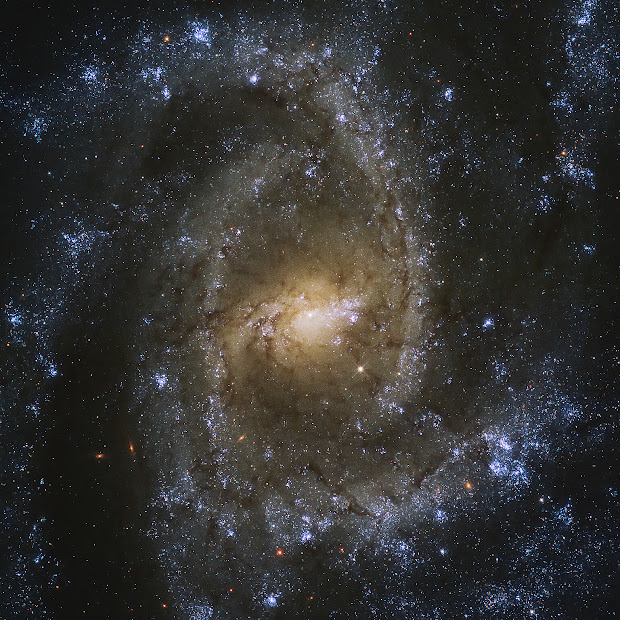
Most of the smears and specks are distant galaxies, but the prominent bright object at the bottom is a foreground star called TYC 4386-787-1. Surrounding Mrk 820 in this image is a good sampling of other galaxy types, covering almost every type found on the Hubble Tuning Fork, both elliptical and spiral. A closer look at the appearance of Mrk 820 reveals hints of a spiral structure embedded in a circular halo of stars. The inner parts of these two spirals trace the boundary. Located in the constellation of Fornax (the Furnace), the blue and fiery orange swirls show us where stars have just formed and the dusty sites. Image credit: NASA & ESA.Lenticular galaxies like Mrk 820 are in the transition zone between ellipticals and spirals and lie right where the fork divides. NGC 1097 is a nearby barred spiral galaxy believed to be interacting with the elliptical galaxy. At around 60 million light-years from Earth, the Great Barred Spiral Galaxy, NGC 1365, is captured beautifully in this image by the NASA/ESA Hubble Space Telescope. “S0,” or lenticular galaxies such as Mrk 820 are in the transition zones between ellipticals and spirals and bridge these two types. A delicate tracery of dust and bright star clusters threads across this image from the James Webb Space Telescope.

The diagram is roughly divided into two parts: elliptical galaxies (ellipticals) and spiral galaxies (spirals). Most spiral galaxies have a big bulge in the center of it, and it is here that the arms start spiraling out. Although this scheme, also known as the Hubble Tuning Fork diagram, is now considered somewhat too simple, the basic ideas still hold. Very little star formation goes on in the bulge. Note that the spiral arms begin at the ends. NGC 1300, shown here, is a barred spiral galaxy. The bulge of a spiral galaxy is composed primarily of old, red stars. Instead of the smooth, graceful arms that emerge from Figure 26.5. American astronomer Edwin Hubble developed a classification scheme of galaxies in 1926. This image of the barred spiral galaxy NGC 5068 is a composite from two of the James Webb Space Telescope’s instruments, MIRI and NIRCam. What type do you think the barred spiral to the right would be The arms of a spiral galaxy have lots of gas and dust, and they are often areas where new stars are constantly forming. The two prongs of the tuning fork represent types of unbarred and barred spiral galaxies. They are arranged along the handle based on how elliptical they are, with the more spherical galaxies furthest from the tines of the fork, and the more egg-shaped ones closest to the end of the handle where it divides. Elliptical galaxies look like smooth blobs in the sky and lie on the handle of the fork. The Hubble Tuning Fork is used to classify galaxies according to their morphology. Grogin (STScI), Acknowledgement: Judy Schmidt.This galaxy is known as Mrk 820 and is classified as a lenticular galaxy - type S0 on the Hubble Tuning Fork. It lies in the constellation Boötes, about 300 million light-years from Earth. Four classes are used to classify galaxies: spiral barred spiral elliptical and irregular.

This Hubble image shows the lenticular galaxy Markarian 820, also known as Mrk 820.


 0 kommentar(er)
0 kommentar(er)
